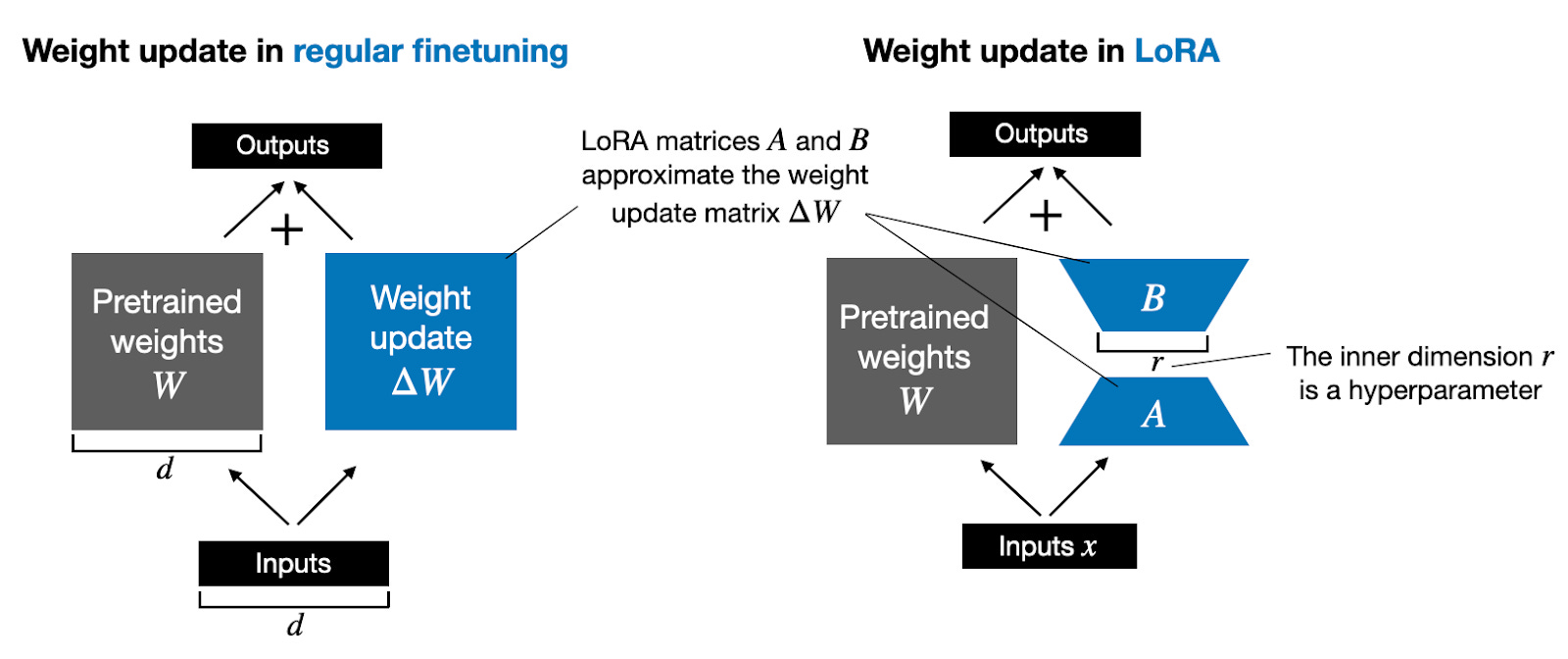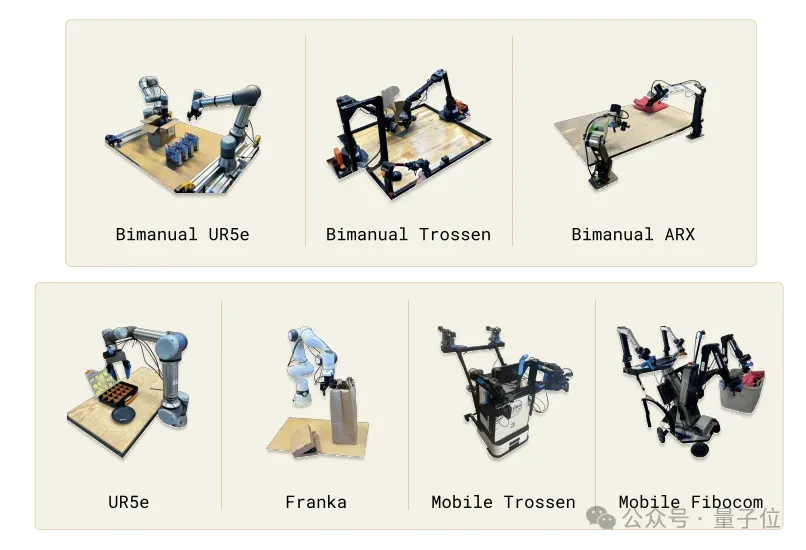
详解PEFT库中LoRA源码
详细解释了PEFT库中的LoRA微调方法源码
·
前言
- GitHub项目地址Some-Paper-CN。本项目是译者在学习长时间序列预测、CV、NLP和机器学习过程中精读的一些论文,并对其进行了中文翻译。还有部分最佳示例教程。
- 如果有帮助到大家,请帮忙点亮Star,也是对译者莫大的鼓励,谢谢啦~
- 本文代码已同步至项目Some-Paper-CN
准备工作
- 从
Github上下载PEFT最新源码,源码地址 - 关键源码在项目文件夹
src/peft下,我们可以在项目文件下新建一个Lora_demo.py文件,用于后期Debug,下面是我写的实例代码,用的Qwen/Qwen2-0.5B-Instruct模型,大家可以用任何自己熟悉的模型。
from pprint import pprint
from peft import LoraConfig, get_peft_model
from transformers import AutoModelForCausalLM, AutoConfig
lora_config = LoraConfig(
task_type="CAUSAL_LM",
target_modules=[
"q_proj",
"k_proj",
"v_proj",
"o_proj",
"gate_proj",
"up_proj",
"down_proj",
],
inference_mode=False,
r=8,
lora_alpha=32,
lora_dropout=0.1,
)
config = AutoConfig.from_pretrained("Qwen/Qwen2-0.5B-Instruct")
og_model = AutoModelForCausalLM.from_config(config)
pprint(og_model)
lora_model = get_peft_model(og_model, lora_config)
pprint(lora_model)
# pprint([key for key, _ in og_model.named_modules()])
# key = 'model.layers.0.self_attn.rotary_emb'
# pprint(og_model.get_submodule(".".join(key.split(".")[:-1])))
# pprint(key.split(".")[-1])
# pprint(og_model.get_submodule(key))
-
后面我注释的是一些在
Debug期间不是很好理解的代码,大家可以先不管,后面到对应的地方后我会提到。 -
可以看到,在上面代码中,最关键的函数是
get_peft_model(),当原始模型经过get_peft_model()函数后,模型结构中就加入了LoRA分支。 -
og_model模型结构
Qwen2ForCausalLM(
(model): Qwen2Model(
(embed_tokens): Embedding(151936, 896)
(layers): ModuleList(
(0-23): 24 x Qwen2DecoderLayer(
(self_attn): Qwen2SdpaAttention(
(q_proj): Linear(in_features=896, out_features=896, bias=True)
(k_proj): Linear(in_features=896, out_features=128, bias=True)
(v_proj): Linear(in_features=896, out_features=128, bias=True)
(o_proj): Linear(in_features=896, out_features=896, bias=False)
(rotary_emb): Qwen2RotaryEmbedding()
)
(mlp): Qwen2MLP(
(gate_proj): Linear(in_features=896, out_features=4864, bias=False)
(up_proj): Linear(in_features=896, out_features=4864, bias=False)
(down_proj): Linear(in_features=4864, out_features=896, bias=False)
(act_fn): SiLU()
)
(input_layernorm): Qwen2RMSNorm()
(post_attention_layernorm): Qwen2RMSNorm()
)
)
(norm): Qwen2RMSNorm()
)
(lm_head): Linear(in_features=896, out_features=151936, bias=False)
)
lora_model模型架构
PeftModelForCausalLM(
(base_model): LoraModel(
(model): Qwen2ForCausalLM(
(model): Qwen2Model(
(embed_tokens): Embedding(151936, 896)
(layers): ModuleList(
(0-23): 24 x Qwen2DecoderLayer(
(self_attn): Qwen2SdpaAttention(
(q_proj): lora.Linear(
(base_layer): Linear(in_features=896, out_features=896, bias=True)
(lora_dropout): ModuleDict(
(default): Dropout(p=0.1, inplace=False)
)
(lora_A): ModuleDict(
(default): Linear(in_features=896, out_features=8, bias=False)
)
(lora_B): ModuleDict(
(default): Linear(in_features=8, out_features=896, bias=False)
)
(lora_embedding_A): ParameterDict()
(lora_embedding_B): ParameterDict()
(lora_magnitude_vector): ModuleDict()
)
(k_proj): lora.Linear(
(base_layer): Linear(in_features=896, out_features=128, bias=True)
(lora_dropout): ModuleDict(
(default): Dropout(p=0.1, inplace=False)
)
(lora_A): ModuleDict(
(default): Linear(in_features=896, out_features=8, bias=False)
)
(lora_B): ModuleDict(
(default): Linear(in_features=8, out_features=128, bias=False)
)
(lora_embedding_A): ParameterDict()
(lora_embedding_B): ParameterDict()
(lora_magnitude_vector): ModuleDict()
)
(v_proj): lora.Linear(
(base_layer): Linear(in_features=896, out_features=128, bias=True)
(lora_dropout): ModuleDict(
(default): Dropout(p=0.1, inplace=False)
)
(lora_A): ModuleDict(
(default): Linear(in_features=896, out_features=8, bias=False)
)
(lora_B): ModuleDict(
(default): Linear(in_features=8, out_features=128, bias=False)
)
(lora_embedding_A): ParameterDict()
(lora_embedding_B): ParameterDict()
(lora_magnitude_vector): ModuleDict()
)
(o_proj): lora.Linear(
(base_layer): Linear(in_features=896, out_features=896, bias=False)
(lora_dropout): ModuleDict(
(default): Dropout(p=0.1, inplace=False)
)
(lora_A): ModuleDict(
(default): Linear(in_features=896, out_features=8, bias=False)
)
(lora_B): ModuleDict(
(default): Linear(in_features=8, out_features=896, bias=False)
)
(lora_embedding_A): ParameterDict()
(lora_embedding_B): ParameterDict()
(lora_magnitude_vector): ModuleDict()
)
(rotary_emb): Qwen2RotaryEmbedding()
)
(mlp): Qwen2MLP(
(gate_proj): lora.Linear(
(base_layer): Linear(in_features=896, out_features=4864, bias=False)
(lora_dropout): ModuleDict(
(default): Dropout(p=0.1, inplace=False)
)
(lora_A): ModuleDict(
(default): Linear(in_features=896, out_features=8, bias=False)
)
(lora_B): ModuleDict(
(default): Linear(in_features=8, out_features=4864, bias=False)
)
(lora_embedding_A): ParameterDict()
(lora_embedding_B): ParameterDict()
(lora_magnitude_vector): ModuleDict()
)
(up_proj): lora.Linear(
(base_layer): Linear(in_features=896, out_features=4864, bias=False)
(lora_dropout): ModuleDict(
(default): Dropout(p=0.1, inplace=False)
)
(lora_A): ModuleDict(
(default): Linear(in_features=896, out_features=8, bias=False)
)
(lora_B): ModuleDict(
(default): Linear(in_features=8, out_features=4864, bias=False)
)
(lora_embedding_A): ParameterDict()
(lora_embedding_B): ParameterDict()
(lora_magnitude_vector): ModuleDict()
)
(down_proj): lora.Linear(
(base_layer): Linear(in_features=4864, out_features=896, bias=False)
(lora_dropout): ModuleDict(
(default): Dropout(p=0.1, inplace=False)
)
(lora_A): ModuleDict(
(default): Linear(in_features=4864, out_features=8, bias=False)
)
(lora_B): ModuleDict(
(default): Linear(in_features=8, out_features=896, bias=False)
)
(lora_embedding_A): ParameterDict()
(lora_embedding_B): ParameterDict()
(lora_magnitude_vector): ModuleDict()
)
(act_fn): SiLU()
)
(input_layernorm): Qwen2RMSNorm()
(post_attention_layernorm): Qwen2RMSNorm()
)
)
(norm): Qwen2RMSNorm()
)
(lm_head): Linear(in_features=896, out_features=151936, bias=False)
)
)
)
- 可以发现,
lora_model对比og_model架构,多了很多以lora为前缀的层,如lora_A,lora_B,lora_embedding_A,lora_embedding_B,那这些层是如何通过函数添加上的呢?按住Ctrl单机get_peft_model()查看底层源码。
源码详解
-
因为一些代码规范的关系,
PEFT内部的源码封装的非常厉害,在解析源码的时候要耐心一点,慢慢看,层级关系也千万要理清楚。 -
进入
get_peft_model函数,跳转到了peft/mapping.py文件,部分注释如下:
def get_peft_model(
model: PreTrainedModel,
peft_config: PeftConfig,
adapter_name: str = "default",
mixed: bool = False,
autocast_adapter_dtype: bool = True,
revision: Optional[str] = None,
) -> PeftModel | PeftMixedModel:
# 读取模型参数文件
model_config = getattr(model, "config", {"model_type": "custom"})
# 将模型参数转换为dict格式
if hasattr(model_config, "to_dict"):
model_config = model_config.to_dict()
# 读取微调配置
peft_config.base_model_name_or_path = model.__dict__.get("name_or_path", None)
if revision is not None:
if peft_config.revision is not None and peft_config.revision != revision:
warnings.warn(
f"peft config has already set base model revision to {peft_config.revision}, overwriting with revision {revision}"
)
peft_config.revision = revision
if mixed:
# note: PeftMixedModel does not support autocast_adapter_dtype, so don't pass it
return PeftMixedModel(model, peft_config, adapter_name=adapter_name)
# 判断任务类型,以便进入对应的微调类
if peft_config.task_type not in MODEL_TYPE_TO_PEFT_MODEL_MAPPING.keys() and not peft_config.is_prompt_learning:
return PeftModel(model, peft_config, adapter_name=adapter_name, autocast_adapter_dtype=autocast_adapter_dtype)
if peft_config.is_prompt_learning:
peft_config = _prepare_prompt_learning_config(peft_config, model_config)
return MODEL_TYPE_TO_PEFT_MODEL_MAPPING[peft_config.task_type](
model, peft_config, adapter_name=adapter_name, autocast_adapter_dtype=autocast_adapter_dtype
)
- 不难发现
get_peft_model()函数的作用是判断当前模型的任务类型,以便进入对应的微调类。在前面的lora_demo.py文件中,lora_config的参数task_type规定了模型类型为CAUSAL_LM因果语言模型,进入MODEL_TYPE_TO_PEFT_MODEL_MAPPING中
MODEL_TYPE_TO_PEFT_MODEL_MAPPING: dict[str, type[PeftModel]] = {
"SEQ_CLS": PeftModelForSequenceClassification,
"SEQ_2_SEQ_LM": PeftModelForSeq2SeqLM,
"CAUSAL_LM": PeftModelForCausalLM,
"TOKEN_CLS": PeftModelForTokenClassification,
"QUESTION_ANS": PeftModelForQuestionAnswering,
"FEATURE_EXTRACTION": PeftModelForFeatureExtraction,
}
CAUSAL_LM对应的是PeftModelForCausalLM类,那我们继续进入PeftModelForCausalLM类- 跳转到
peft/peft_model.py文件,发现PeftModelForCausalLM类继承自PeftModel类,进入PeftModel类,我们主要关注PeftModel类的初始化方法,部分注释如下:
class PeftModel(PushToHubMixin, torch.nn.Module):
def __init__(
self,
model: PreTrainedModel,
peft_config: PeftConfig,
adapter_name: str = "default",
autocast_adapter_dtype: bool = True,
) -> None:
super().__init__()
self.modules_to_save = None
self.active_adapter = adapter_name
# 获取微调方法
self.peft_type = peft_config.peft_type
# These args are special PEFT arguments that users can pass. They need to be removed before passing them to
# forward.
self.special_peft_forward_args = {"adapter_names"}
# 判断是否为提示词学习方法
self._is_prompt_learning = peft_config.is_prompt_learning
if self._is_prompt_learning:
self._peft_config = {adapter_name: peft_config}
self.base_model = model
self.add_adapter(adapter_name, peft_config)
else:
self._peft_config = None
# 获取微调方法类
cls = PEFT_TYPE_TO_MODEL_MAPPING[peft_config.peft_type]
# 实例化微调方法类
self.base_model = cls(model, {adapter_name: peft_config}, adapter_name)
self.set_additional_trainable_modules(peft_config, adapter_name)
if hasattr(self.base_model, "_cast_adapter_dtype"):
self.base_model._cast_adapter_dtype(
adapter_name=adapter_name, autocast_adapter_dtype=autocast_adapter_dtype
)
if getattr(model, "is_gradient_checkpointing", True):
model = self._prepare_model_for_gradient_checkpointing(model)
# the `pretraining_tp` is set for some models to simulate Tensor Parallelism during inference to avoid
# numerical differences, https://github.com/pytorch/pytorch/issues/76232 - to avoid any unexpected
# behavior we disable that in this line.
if hasattr(self.base_model, "config") and hasattr(self.base_model.config, "pretraining_tp"):
self.base_model.config.pretraining_tp = 1
PeftModel类的作用是实例化对应的微调方法类,需要注意的是LoRA微调方法不属于提示词学习方法,要注意if self._is_prompt_learning判断结果,应该走else分支- 进入
PEFT_TYPE_TO_MODEL_MAPPING
PEFT_TYPE_TO_MODEL_MAPPING = {
PeftType.LORA: LoraModel,
PeftType.LOHA: LoHaModel,
PeftType.LOKR: LoKrModel,
PeftType.PROMPT_TUNING: PromptEmbedding,
PeftType.P_TUNING: PromptEncoder,
PeftType.PREFIX_TUNING: PrefixEncoder,
PeftType.ADALORA: AdaLoraModel,
PeftType.BOFT: BOFTModel,
PeftType.ADAPTION_PROMPT: AdaptionPromptModel,
PeftType.IA3: IA3Model,
PeftType.OFT: OFTModel,
PeftType.POLY: PolyModel,
PeftType.LN_TUNING: LNTuningModel,
PeftType.VERA: VeraModel,
}
LoRA微调方法对应LoraModel类,进入LoraModel类,跳转到peft/tuners/lora/model.py文件,发现LoraModel类继承自BaseTuner类,那我们继续进入BaseTuner类,跳转到peft/tuners/tuners_utils.py文件。- 还是重点关注
BaseTuner类的初始化方法,部分注释如下:
class BaseTuner(nn.Module, ABC):
def __init__(self, model, peft_config: Union[PeftConfig, dict[str, PeftConfig]], adapter_name: str) -> None:
super().__init__()
self.model = model
self.targeted_module_names: list[str] = []
# For advanced developers, if you want to attach multiple adapters to your
# model, just add a `peft_config` dict attribute to your model.
if not hasattr(self, "peft_config"):
self.peft_config = {adapter_name: peft_config} if isinstance(peft_config, PeftConfig) else peft_config
else:
logger.info(
"Already found a `peft_config` attribute in the model. This will lead to having multiple adapters"
" in the model. Make sure to know what you are doing!"
)
if isinstance(peft_config, PeftConfig):
self.peft_config[adapter_name] = peft_config
else:
# user is adding a dict of PeftConfigs
self.peft_config.update(peft_config)
self.active_adapter: str | list[str] = adapter_name
self._pre_injection_hook(self.model, self.peft_config[adapter_name], adapter_name)
# 插入Adapter模块
self.inject_adapter(self.model, adapter_name)
# Copy the peft_config in the injected model.
self.model.peft_config = self.peft_config
- 上面初始化方法有一些指标记录和信息输出的代码,最关键的函数是
inject_adapter(),即插入Adapter模块,进入inject_adapter()函数中 inject_adapter()函数仍然在peft/tuners/tuners_utils.py文件中,部分注释如下
def inject_adapter(self, model: nn.Module, adapter_name: str, autocast_adapter_dtype: bool = True) -> None:
# 读取配置文件
peft_config = self.peft_config[adapter_name]
self._check_new_adapter_config(peft_config)
_check_for_modules_to_save = getattr(peft_config, "modules_to_save", None) is not None
_has_modules_to_save = False
model_config = getattr(model, "config", {"model_type": "custom"})
if hasattr(model_config, "to_dict"):
model_config = model_config.to_dict()
peft_config = self._prepare_adapter_config(peft_config, model_config)
self._prepare_model(peft_config, model)
is_target_modules_in_base_model = False
# 存储模型每一层的名字
key_list = [key for key, _ in model.named_modules()]
# update peft_config.target_modules if required
peft_config = _maybe_include_all_linear_layers(peft_config, model)
for key in key_list:
# Check for modules_to_save in case
if _check_for_modules_to_save and any(
key.endswith(f"{module_to_save}") for module_to_save in peft_config.modules_to_save
):
# Optionally set the modules to save
parent, target, target_name = _get_submodules(model, key)
if not isinstance(target, ModulesToSaveWrapper):
new_module = ModulesToSaveWrapper(target, adapter_name)
setattr(parent, target_name, new_module)
else:
target.update(adapter_name)
_has_modules_to_save = True
continue
if not self._check_target_module_exists(peft_config, key):
continue
self.targeted_module_names.append(key)
is_target_modules_in_base_model = True
# 获取当前层的父模块类,层名,层名对应的模块类
parent, target, target_name = _get_submodules(model, key)
# 创建层替代原本的层
self._create_and_replace(peft_config, adapter_name, target, target_name, parent, current_key=key)
if not is_target_modules_in_base_model:
raise ValueError(
f"Target modules {peft_config.target_modules} not found in the base model. "
f"Please check the target modules and try again."
)
self.set_adapter(self.active_adapters)
self._mark_only_adapters_as_trainable(model)
if self.peft_config[adapter_name].inference_mode:
for n, p in model.named_parameters():
if adapter_name in n:
p.requires_grad = False
if _has_modules_to_save:
if not hasattr(model, "modules_to_save"):
model.modules_to_save = set(peft_config.modules_to_save)
else:
model.modules_to_save.update(set(peft_config.modules_to_save))
inject_adapter()函数的关键行为是用key_list存储了模型每一层的名字,可以在前面我们写的lora_demo.py文件中打印出来。
pprint([key for key, _ in og_model.named_modules()])
输出如下,因为后面都是重复的模块,这里只截取了第0个模块的各个层
['',
'model',
'model.embed_tokens',
'model.layers',
'model.layers.0',
'model.layers.0.self_attn',
'model.layers.0.self_attn.q_proj',
'model.layers.0.self_attn.k_proj',
'model.layers.0.self_attn.v_proj',
'model.layers.0.self_attn.o_proj',
'model.layers.0.self_attn.rotary_emb',
'model.layers.0.mlp',
'model.layers.0.mlp.gate_proj',
'model.layers.0.mlp.up_proj',
'model.layers.0.mlp.down_proj',
'model.layers.0.mlp.act_fn',
'model.layers.0.input_layernorm',
'model.layers.0.post_attention_layernorm',
...
- 接着通过遍历
key_list获取当前层的父模块类,层名,层名对应的模块类。比较重要的函数是_get_submodules(),点击_get_submodules()函数,跳转到peft/utils/other.py文件,看看是如何实现的。
def _get_submodules(model, key):
parent = model.get_submodule(".".join(key.split(".")[:-1]))
target_name = key.split(".")[-1]
target = model.get_submodule(key)
return parent, target, target_name
- 这个函数可以在前面我们写的
lora_demo.py文件中打印出来。随便选一个key,比如model.layers.0.self_attn.rotary_emb
key = 'model.layers.0.self_attn.rotary_emb'
pprint(og_model.get_submodule(".".join(key.split(".")[:-1])))
pprint(key.split(".")[-1])
pprint(og_model.get_submodule(key))
得到的输出如下:
"""
key = model.layers.0.self_attn.rotary_emb
parent = Qwen2SdpaAttention(
(q_proj): Linear(in_features=896, out_features=896, bias=True)
(k_proj): Linear(in_features=896, out_features=128, bias=True)
(v_proj): Linear(in_features=896, out_features=128, bias=True)
(o_proj): Linear(in_features=896, out_features=896, bias=False)
(rotary_emb): Qwen2RotaryEmbedding()
)
target_name = 'rotary_emb'
target = Qwen2RotaryEmbedding()
"""
- 我们回到
peft/tuners/tuners_utils.py文件中,继续看inject_adapter()函数,另一个关键函数是_create_and_replace()函数,我们点击_create_and_replace()函数,其与inject_adapter()函数在一个文件中,但是_create_and_replace()函数是一个抽象函数,我们需要回到peft/tuners/lora/model.py文件,LoraModel类中搜索_create_and_replace()函数查看具体实现。
def _create_and_replace(
self,
lora_config,
adapter_name,
target,
target_name,
parent,
current_key,
):
if current_key is None:
raise ValueError("Current Key shouldn't be `None`")
# Regexp 匹配 - 在提供的模式中查找与当前目标名称匹配的键值
pattern_keys = list(chain(lora_config.rank_pattern.keys(), lora_config.alpha_pattern.keys()))
target_name_key = next(filter(lambda key: re.match(rf".*\.{key}$", current_key), pattern_keys), current_key)
# 获取r和alpha参数
r = lora_config.rank_pattern.get(target_name_key, lora_config.r)
alpha = lora_config.alpha_pattern.get(target_name_key, lora_config.lora_alpha)
kwargs = {
"r": r,
"lora_alpha": alpha,
"lora_dropout": lora_config.lora_dropout,
"fan_in_fan_out": lora_config.fan_in_fan_out,
"init_lora_weights": lora_config.init_lora_weights,
"use_rslora": lora_config.use_rslora,
"use_dora": lora_config.use_dora,
"loaded_in_8bit": getattr(self.model, "is_loaded_in_8bit", False),
"loaded_in_4bit": getattr(self.model, "is_loaded_in_4bit", False),
}
quant_methods = ["gptq", "aqlm", "awq"]
for quant_method in quant_methods:
quantization_config = get_quantization_config(self.model, method=quant_method)
if quantization_config is not None:
kwargs[f"{quant_method}_quantization_config"] = quantization_config
# note: AdaLoraLayer is a subclass of LoraLayer, we need to exclude it
from peft.tuners.adalora import AdaLoraLayer
# 当前传入的模型还是原始的基于nn.module的模型,所以不属于LoraLayer或Adaloralayer
# 应该走else
if isinstance(target, LoraLayer) and not isinstance(target, AdaLoraLayer):
target.update_layer(
adapter_name,
r,
lora_alpha=alpha,
lora_dropout=lora_config.lora_dropout,
init_lora_weights=lora_config.init_lora_weights,
use_rslora=lora_config.use_rslora,
use_dora=lora_config.use_dora,
)
else:
# 根据LoRA关键参数创建新的模型
new_module = self._create_new_module(lora_config, adapter_name, target, **kwargs)
if adapter_name not in self.active_adapters:
# adding an additional adapter: it is not automatically trainable
new_module.requires_grad_(False)
self._replace_module(parent, target_name, new_module, target)
_create_and_replace()函数在获取了LoRA微调的关键参数r和alpha后,使用_create_new_module()函数创建新的模型架构。- 需要注意的是,现在传入该函数的模型是原始的,基于
torch.nn.module的模型,不属于LoraLayer或者AdaLoraLayer类型,应该要走下面的else分支。 - 进入
_create_new_module()函数,与_create_and_replace()函数在同一文件下,
def _create_new_module(lora_config, adapter_name, target, **kwargs):
dispatchers = []
if lora_config._custom_modules:
def dynamic_dispatch_func(target, adapter_name, lora_config, **kwargs):
new_module = None
if isinstance(target, BaseTunerLayer):
target_base_layer = target.get_base_layer()
else:
target_base_layer = target
for key, custom_cls in lora_config._custom_modules.items():
if isinstance(target_base_layer, key):
new_module = custom_cls(target, adapter_name, **kwargs)
break
return new_module
dispatchers.append(dynamic_dispatch_func)
# avoid eager bnb import
if is_bnb_available():
from .bnb import dispatch_bnb_8bit
dispatchers.append(dispatch_bnb_8bit)
if is_bnb_4bit_available():
from .bnb import dispatch_bnb_4bit
dispatchers.append(dispatch_bnb_4bit)
dispatchers.extend(
[
dispatch_eetq,
dispatch_aqlm,
dispatch_awq,
dispatch_gptq,
dispatch_hqq,
dispatch_megatron,
dispatch_default,
]
)
new_module = None
for dispatcher in dispatchers:
new_module = dispatcher(target, adapter_name, lora_config=lora_config, **kwargs)
if new_module is not None: # first match wins
break
if new_module is None:
# no module could be matched
raise ValueError(
f"Target module {target} is not supported. Currently, only the following modules are supported: "
"`torch.nn.Linear`, `torch.nn.Embedding`, `torch.nn.Conv2d`, `transformers.pytorch_utils.Conv1D`."
)
return new_module
- 上面函数提到的
awq、gptq、hqq都是不同的模型量化或部署格式,一般我们微调选择的都是非量化版本,所以最后都会走dispatch_default分支,但是我们也可以看看其他的分支,这里以dispatch_eetq()函数为例,点击跳转到peft/tuners/lora/eetq.py文件
def dispatch_eetq(
target: torch.nn.Module,
adapter_name: str,
**kwargs: Any,
) -> Optional[torch.nn.Module]:
new_module = None
if isinstance(target, BaseTunerLayer):
target_base_layer = target.get_base_layer()
else:
target_base_layer = target
if is_eetq_available() and isinstance(target_base_layer, EetqLinear):
new_module = EetqLoraLinear(target, adapter_name, **kwargs)
target.weight = target_base_layer.weight
if hasattr(target, "bias"):
target.bias = target_base_layer.bias
return new_module
- 函数先初始化了
new_module为None,但是由于is_eetq_available()和isinstance(target_base_layer, EetqLinear)均为False,最后的new_module仍然为None - 回到
peft/tuners/lora/model.py文件下的_create_new_module()函数,点击dispatch_default,跳转到peft/tuners/lora/layer.py文件下的dispatch_default()函数,部分注释如下。
def dispatch_default(
target: torch.nn.Module,
adapter_name: str,
lora_config: LoraConfig,
**kwargs,
) -> Optional[torch.nn.Module]:
new_module = None
if isinstance(target, BaseTunerLayer):
target_base_layer = target.get_base_layer()
else:
target_base_layer = target
# 更新Embedding层
if isinstance(target_base_layer, torch.nn.Embedding):
embedding_kwargs = kwargs.copy()
embedding_kwargs.pop("fan_in_fan_out", None)
embedding_kwargs.update(lora_config.loftq_config)
new_module = Embedding(target, adapter_name, **embedding_kwargs)
# 更新Conv2d层
elif isinstance(target_base_layer, torch.nn.Conv2d):
kwargs.update(lora_config.loftq_config)
new_module = Conv2d(target, adapter_name, **kwargs)
# 更新Linear层
elif isinstance(target_base_layer, torch.nn.Linear):
if kwargs["fan_in_fan_out"]:
warnings.warn(
"fan_in_fan_out is set to True but the target module is `torch.nn.Linear`. "
"Setting fan_in_fan_out to False."
)
kwargs["fan_in_fan_out"] = lora_config.fan_in_fan_out = False
kwargs.update(lora_config.loftq_config)
new_module = Linear(target, adapter_name, **kwargs)
# 更新Conv1D层
elif isinstance(target_base_layer, Conv1D):
if not kwargs["fan_in_fan_out"]:
warnings.warn(
"fan_in_fan_out is set to False but the target module is `Conv1D`. " "Setting fan_in_fan_out to True."
)
kwargs["fan_in_fan_out"] = lora_config.fan_in_fan_out = True
kwargs.update(lora_config.loftq_config)
new_module = Linear(target, adapter_name, is_target_conv_1d_layer=True, **kwargs)
return new_module
- 可以看到
LoRA微调方法主要是针对Embedding、Conv1D、Conv2D、Linear层,这里我们以Linear为例进行讲解。 - 进入
isinstance(target_base_layer, torch.nn.Linear)分支下的new_module = Linear(target, adapter_name, **kwargs),点击Linear,Linear类与dispatch_default()函数处于同一文件。
class Linear(nn.Module, LoraLayer):
def __init__(
self,
base_layer,
adapter_name: str,
r: int = 0,
lora_alpha: int = 1,
lora_dropout: float = 0.0,
fan_in_fan_out: bool = False,
is_target_conv_1d_layer: bool = False,
init_lora_weights: Union[bool, str] = True,
use_rslora: bool = False,
use_dora: bool = False,
**kwargs,
) -> None:
super().__init__()
LoraLayer.__init__(self, base_layer, **kwargs)
self.fan_in_fan_out = fan_in_fan_out
self._active_adapter = adapter_name
self.update_layer(
adapter_name,
r,
lora_alpha=lora_alpha,
lora_dropout=lora_dropout,
init_lora_weights=init_lora_weights,
use_rslora=use_rslora,
use_dora=use_dora,
)
self.is_target_conv_1d_layer = is_target_conv_1d_layer
- 可以看到
Linear类除了继承nn.Module类,还继承了LoraLayer类,我们先看LoraLayer类,点击进入与Linear类同一文件的LoraLayer类,主要关注LoraLayer类的初始化方法
class LoraLayer(BaseTunerLayer):
adapter_layer_names = ("lora_A", "lora_B", "lora_embedding_A", "lora_embedding_B")
other_param_names = ("r", "lora_alpha", "scaling", "lora_dropout")
def __init__(self, base_layer: nn.Module, **kwargs) -> None:
self.base_layer = base_layer
self.r = {}
self.lora_alpha = {}
self.scaling = {}
self.lora_dropout = nn.ModuleDict({})
self.lora_A = nn.ModuleDict({})
self.lora_B = nn.ModuleDict({})
self.lora_embedding_A = nn.ParameterDict({})
self.lora_embedding_B = nn.ParameterDict({})
self._disable_adapters = False
self.merged_adapters = []
self.use_dora: dict[str, bool] = {}
self.lora_magnitude_vector = torch.nn.ModuleDict() # for DoRA
self._caches: dict[str, Any] = {}
self.kwargs = kwargs
base_layer = self.get_base_layer()
# 获取输入输出维度
if isinstance(base_layer, nn.Linear):
in_features, out_features = base_layer.in_features, base_layer.out_features
elif isinstance(base_layer, nn.Conv2d):
in_features, out_features = base_layer.in_channels, base_layer.out_channels
elif isinstance(base_layer, nn.Embedding):
in_features, out_features = base_layer.num_embeddings, base_layer.embedding_dim
elif isinstance(base_layer, Conv1D):
in_features, out_features = (
base_layer.weight.ds_shape if hasattr(base_layer.weight, "ds_shape") else base_layer.weight.shape
)
elif hasattr(base_layer, "infeatures") and hasattr(base_layer, "outfeatures"):
in_features, out_features = base_layer.infeatures, base_layer.outfeatures
elif hasattr(base_layer, "input_size") and hasattr(base_layer, "output_size"):
in_features, out_features = base_layer.input_size, base_layer.output_size
elif hasattr(base_layer, "codebooks") and base_layer.__class__.__name__ == "QuantizedLinear":
in_features, out_features = base_layer.in_features, base_layer.out_features
elif hasattr(base_layer, "w_bit") and base_layer.__class__.__name__ == "WQLinear_GEMM":
in_features, out_features = base_layer.in_features, base_layer.out_features
elif base_layer.__class__.__name__ == "EetqLinear":
in_features, out_features = base_layer.in_features, base_layer.out_features
elif hasattr(base_layer, "W_q") and base_layer.__class__.__name__ == "HQQLinear":
in_features, out_features = base_layer.in_features, base_layer.out_features
else:
if hasattr(base_layer, "in_features") and hasattr(base_layer, "out_features"):
in_features, out_features = base_layer.in_features, base_layer.out_features
else:
in_features, out_features = None, None
warnings.warn(
f"Unsupported layer type '{type(base_layer)}' encountered, proceed at your own risk.", UserWarning
)
self.in_features = in_features
self.out_features = out_features
LoraLayer类的初始化方法关键行为在于获取可调节层(Embedding、Conv1D、Conv2D、Linear)的输入输出维度,方便构造新的层。- 我们回到
Linear类中,Linear类的初始化中另外一个关键方法是update_layer(),点击进入update_layer()函数中。 - 到这里我终于可以把
LoRA微调方法的经典原理图放上来了。

def update_layer(
self, adapter_name, r, lora_alpha, lora_dropout, init_lora_weights, use_rslora, use_dora: bool = False
):
# This code works for linear layers, override for other layer types
if r <= 0:
raise ValueError(f"`r` should be a positive integer value but the value passed is {r}")
# 读取r、alpha参数
self.r[adapter_name] = r
self.lora_alpha[adapter_name] = lora_alpha
# 如果存在dropout参数则加入Dropout层
if lora_dropout > 0.0:
lora_dropout_layer = nn.Dropout(p=lora_dropout)
else:
lora_dropout_layer = nn.Identity()
# 在lora_dropout中加入lora_dropout_layer
self.lora_dropout.update(nn.ModuleDict({adapter_name: lora_dropout_layer}))
# 实际可训练参数,矩阵A,B
self.lora_A[adapter_name] = nn.Linear(self.in_features, r, bias=False)
self.lora_B[adapter_name] = nn.Linear(r, self.out_features, bias=False)
if use_rslora:
self.scaling[adapter_name] = lora_alpha / math.sqrt(r)
else:
self.scaling[adapter_name] = lora_alpha / r
# for inits that require access to the base weight, use gather_param_ctx so that the weight is gathered when using DeepSpeed
if isinstance(init_lora_weights, str) and init_lora_weights.startswith("pissa"):
with gather_params_ctx(self.get_base_layer().weight):
self.pissa_init(adapter_name, init_lora_weights)
elif isinstance(init_lora_weights, str) and init_lora_weights.lower() == "olora":
with gather_params_ctx(self.get_base_layer().weight):
self.olora_init(adapter_name)
elif init_lora_weights == "loftq":
with gather_params_ctx(self.get_base_layer().weight):
self.loftq_init(adapter_name)
elif init_lora_weights:
self.reset_lora_parameters(adapter_name, init_lora_weights)
# call this before dora_init
self._move_adapter_to_device_of_base_layer(adapter_name)
if use_dora:
self.dora_init(adapter_name)
self.use_dora[adapter_name] = True
else:
self.use_dora[adapter_name] = False
# 设置可训练参数
self.set_adapter(self.active_adapters)
update_layer()方法的关键行为有:- 1、读取
LoRA关键参数r、alpha - 2、根据
Dropout参数判断是否加入Dropout层 - 3、创建
lora_A、lora_B线性层,并进行初始化。lora_A的初始化有多种方式,lora_B的初始值均为0,这样lora分支的值在没开始训练之前为0,不改变原模型权重值。 - 设置
lora分支为可训练参数,冻结其它层
- 1、读取
lora_A层的初始化方法可以在reset_lora_parameters()方法中找到,部分注释如下
def reset_lora_parameters(self, adapter_name, init_lora_weights):
if init_lora_weights is False:
return
if adapter_name in self.lora_A.keys():
# 若init_lora_weights为true则使用kaiming初始化
if init_lora_weights is True:
nn.init.kaiming_uniform_(self.lora_A[adapter_name].weight, a=math.sqrt(5))
# 如果为gaussian则进行正态初始化
elif init_lora_weights.lower() == "gaussian":
nn.init.normal_(self.lora_A[adapter_name].weight, std=1 / self.r[adapter_name])
else:
raise ValueError(f"Unknown initialization {init_lora_weights=}")
# 对B矩阵使用全0初始化
nn.init.zeros_(self.lora_B[adapter_name].weight)
if adapter_name in self.lora_embedding_A.keys():
nn.init.zeros_(self.lora_embedding_A[adapter_name])
nn.init.normal_(self.lora_embedding_B[adapter_name])
- 设置可训练参数可以查看
set_adapter()方法,部分注释如下
def set_adapter(self, adapter_names: str | list[str]) -> None:
if isinstance(adapter_names, str):
adapter_names = [adapter_names]
for layer_name in self.adapter_layer_names:
module_dict = getattr(self, layer_name)
for key, layer in module_dict.items():
# 如果是adapter_names中需要训练的层,则开启梯度传播,否则关闭
if key in adapter_names:
layer.requires_grad_(True)
else:
layer.requires_grad_(False)
self._active_adapter = adapter_names
- 看完
Linear类的初始化方法,还可以看一下forward方法,描述了LoRA模型如何与原模型推理的结果进行合并的,代码部分注释如下
def forward(self, x: torch.Tensor, *args: Any, **kwargs: Any) -> torch.Tensor:
self._check_forward_args(x, *args, **kwargs)
adapter_names = kwargs.pop("adapter_names", None)
if self.disable_adapters:
if self.merged:
self.unmerge()
result = self.base_layer(x, *args, **kwargs)
elif adapter_names is not None:
result = self._mixed_batch_forward(x, *args, adapter_names=adapter_names, **kwargs)
elif self.merged:
result = self.base_layer(x, *args, **kwargs)
else:
# 得到原始模型中的结果
result = self.base_layer(x, *args, **kwargs)
torch_result_dtype = result.dtype
for active_adapter in self.active_adapters:
if active_adapter not in self.lora_A.keys():
continue
lora_A = self.lora_A[active_adapter]
lora_B = self.lora_B[active_adapter]
dropout = self.lora_dropout[active_adapter]
scaling = self.scaling[active_adapter]
x = x.to(lora_A.weight.dtype)
if not self.use_dora[active_adapter]:
# 原始模型输出+可训练lora层的结果
result = result + lora_B(lora_A(dropout(x))) * scaling
else:
x = dropout(x)
result = result + self.lora_magnitude_vector[active_adapter](
x,
lora_A=lora_A,
lora_B=lora_B,
scaling=scaling,
base_layer=self.get_base_layer(),
)
result = result.to(torch_result_dtype)
return result
- 到这里,关于
LoRA部分的源码就解析完了,后面就是训练这些标记为可训练参数的模块。
后记
PEFT库是我看过的,封装的比较复制的库了,虽然看起来很繁琐,但是在看这些源码的过程中,我也逐渐明白了为什么代码需要这样构建,以后如果需要构建自己的大型项目应该如何做,受益匪浅。- 在这里也希望大家能深入底层原理去了解算法,只有明白了其机理,才知道算法的优缺点
更多推荐
 已为社区贡献1条内容
已为社区贡献1条内容










所有评论(0)